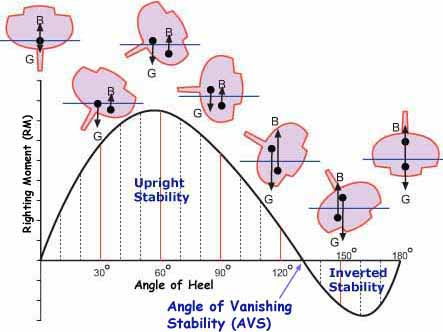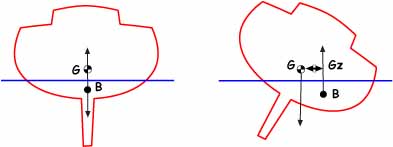Reading the All-Revealing Gz Curve for Sailboat Stability
In a Nutshell
A Gz curve is a graph that plots a sailboat's righting lever against its angle of heel. It is a critical tool for understanding a boat's static stability and resistance to capsize. The curve reveals three key pieces of information: the maximum righting moment, the Angle of Vanishing Stability (AVS), and the energy required to capsize the boat.
A well-designed cruising boat will have a high maximum righting moment and a high AVS, giving you the confidence needed for offshore passages.
 A typical Gz Curve for a monohull
A typical Gz Curve for a monohullTable of Contents
- What Are Gz Curves & Why Do They Matter?
- How Do I Interpret the Gz Curve & Angle of Vanishing Stability?
- What Other Factors Influence Gz Curves & Stability?
- Can a Sailor Influence the Righting Moment?
- How Do Gz Curves Differ for Monohulls & Multihulls?
- What About the Ballast Ratio?
- Frequently Asked Questions (FAQs)
What Are Gz Curves & Why Do They Matter?
Few sailing magazines fail to include stability data in the form of Gz curves in their new sailboat reviews, and for good reason—they provide the most revealing insight into a sailboat's resistance to capsize. At least from a static perspective, that is. To get a complete understanding of seaworthiness, dynamic stability must also be taken into account.
But back to the curve... just how does it reveal its secrets? The key to it all is the boat's centre of gravity, its centre of buoyancy and the changing distance between them as the boat heels to the wind.
The Gz curve illustrates the relationship between the three key factors that determine the boat's static stability: the Centre of Gravity (G), the Centre of Buoyancy (B), and the Lever Arm (Gz).
- The Centre of Gravity (G): The point through which gravity exerts a downward force equal to the displacement of the boat.
- The Centre of Buoyancy (B): The centre of the underwater volume of the boat, whose upward thrust counteracts the effect of gravity acting through G.
- The Lever Arm (Gz): The horizontal distance between G and B.

The location of G is fixed, unlike B which changes as the boat heels and the immersed section changes shape. As the Centre of Gravity and the Centre of Buoyancy initially move apart and then converge, so the length of the Gz—the righting lever—increases and decreases. This relationship between heel angle and righting moment governs the shape of the Gz curve and defines the boat's static stability.
How Do I Interpret the Gz Curve & Angle of Vanishing Stability?
Thankfully, it is not necessary to emulate the alarming sequence of events illustrated by the diagram to establish Gz curves. These are produced by calculation—these days probably via the designer's hull design software.
Let's look at what happens to a typical monohull ballasted sailing yacht as it heels:
- When the boat is upright: G is in the same vertical plane as the Centre of Buoyancy and there is no righting lever.
- As the boat heels: B will move to leeward and a righting lever is generated.
- The righting lever increases: The righting lever will increase to a maximum (in our example at 60° of heel) and then start diminishing.
- The Angle of Vanishing Stability (AVS): This is the point where B is once again in the same vertical plane as G, and the righting lever is zero. In our sample Gz curve, this occurs at 130°. Beyond this point, the Gz becomes negative and acts as a capsizing lever rather than a righting lever.
- Inverted stability: Unless affected by some outside force, the boat will continue to 180° of heel until the CG and CB are in the same vertical plane and the boat is stable again—albeit the wrong way up.
What Other Factors Influence Gz Curves & Stability?
It is clear that hull form has a significant effect on stability. When heeling, wide, flat-bottomed hulls move the CB outboard more rapidly than narrower, 'slack bilged' hulls. In general then, the beamier the boat the greater the form stability.
Other factors at extreme angles of heel, such as freeboard, deck camber and coachroof design also affect stability. A good height of freeboard will improve both the maximum righting moment and the limit of positive stability. A flush-decked boat or one with a very low profile coachroof will be more stable when inverted than a similar hull with a high, narrow superstructure. A low centre of gravity is always a positive contributor to stability.
Can a Sailor Influence the Righting Moment?
Normally, the centre of gravity will be on the centreline in a properly trimmed boat, but it can be persuaded to move further from B to give a marked enhancement on the righting lever. In my younger days, I have spent many hours perched on the side deck of a club raceboat with the toerail cutting off the blood supply my lower limbs, frozen to the core, and with only the prospect of a beer or two back in the Saltash Sailing Club preventing my immediate mutiny.
This is a very simple real-world example of moving weight to increase the righting moment, but this principle is also used in more technical ways. For example, some offshore racing yachts, and even some cruising boats, can increase the righting moment when it is beneficial to do so by flooding seawater ballast tanks on the windward side.
How Do Gz Curves Differ for Monohulls & Multihulls?
| Characteristic | Monohulls | Multihulls |
|---|---|---|
| Primary Stability Source | Ballast & Hull Form | Hull Form (primarily beam) |
| Gz Curve Shape | Bell-shaped, with a peak and AVS | Almost flat initially, then a sharp, steep fall |
| Angle of Vanishing Stability (AVS) | Typically 110-140 degrees | A very low angle, often less than 20 degrees |
| Recovery from Knockdown | Self-righting, will return to upright position | Will remain inverted once capsized |
| Heeling Action | Designed to heel to a safe angle under sail | Designed to stay upright, with minimal heel |
For offshore yachts, one of the most apparent and meaningful aspects of the curve is the AVS. However, because the force required to heel a heavy boat is more than that required to heel a lighter one, then clearly the boat's mass (or displacement) is also a significant factor. So, by multiplying the righting lever by the boat's mass, the righting lever becomes a righting moment (length x mass), and the Gz curve can also be considered as a Righting Moment (RM) curve.
As the area under the RM curve represents the energy needed to heel the boat, a boat of double the displacement will need twice the energy to capsize—and twice the energy to right itself following a capsize. All else being equal, then, heavy boats are inherently more stable than light ones.
What About the Ballast Ratio?
It is worth mentioning that the oft-quoted ballast ratio can be misleading when considering stability. This ratio is a measure of the percentage of a boat's displacement taken up by ballast. Although it can give some indication of how stiff or tender a sailboat may be, it takes no account of the location of the ballast or the hull shape of the boat. Two sailboats can have the same ballast ratios with very different righting moments.
If the hulls are the same, a sailboat with all its ballast in a bulb at the bottom of the keel will be stiffer than a sailboat with a long shoal-draft keel even though they may have the same ballast ratio, and their Gz curves will be quite different. For instance, a bilge keeler may well have the same ballast ratio as a club racer, but there is little doubt that the club racer will be the stiffer boat.
Understanding your sailboat's Gz curve is just one part of mastering your vessel. To learn more about other critical design elements & regulations that define a boat's performance and safety, continue to our article on "Mastering Sailboat Design Ratios & Regulation for Performance & Safety".
This article was written by Dick McClary, RYA Yachtmaster and author of the RYA publications 'Offshore Sailing' and 'Fishing Afloat', member of The Yachting Journalists Association (YJA), and erstwhile member of the Ocean Cruising Club (OCC).
Frequently Asked Questions (FAQs)
What is the difference between static and dynamic stability?
What is the difference between static and dynamic stability?
Static stability is the boat's resistance to capsize in calm water, represented by the Gz curve. Dynamic stability, however, is the boat's ability to resist capsize when exposed to dynamic forces like waves, gusts, and rapid motions.
How does a sailor use a Gz curve to choose a boat?
How does a sailor use a Gz curve to choose a boat?
A Gz curve is a crucial part of a boat's stability report. For offshore cruising, a sailor should look for a high Angle of Vanishing Stability (AVS) and a large area under the curve, as this indicates the boat has a high reserve of stability and is better equipped to handle heavy weather.
Does a boat with a high AVS always mean it is a safe boat?
Does a boat with a high AVS always mean it is a safe boat?
Not necessarily. While a high AVS is desirable for offshore sailing, it is only one component of a boat's overall safety profile. Other factors like cockpit design, deck security, and the strength of the rig and hull are equally important.
What is a righting moment?
What is a righting moment?
The righting moment is the force that acts to return a heeled boat to an upright position. It is calculated by multiplying the righting lever (Gz) by the boat's displacement.
Recent Articles
-
Yacht Clearance in the Caribbean: A Sailor's Guide
Nov 25, 25 07:13 AM
Navigating yacht clearance in the Caribbean is essential for a smooth sailing trip. This guide, written by an experienced sailor, explains the required papers, procedures & tips for a hassle-free expe… -
Beneteau Oceanis 36CC: Specs, Ratios & Cruising Suitability
Nov 25, 25 06:08 AM
Detailed analysis of the Beneteau Oceanis 36CC centre cockpit sailboat. Includes design ratios, full specifications, and practical assessment of its suitability for experienced offshore and liveaboard… -
Essential Boat Toilet Maintenance & Systems: A Sailor’s Guide
Nov 24, 25 01:17 PM
Master boat toilet maintenance, from manual sea heads to 12v electric systems. Get an experienced offshore sailor’s guide on avoiding clogs, leaks, & bad smells.












